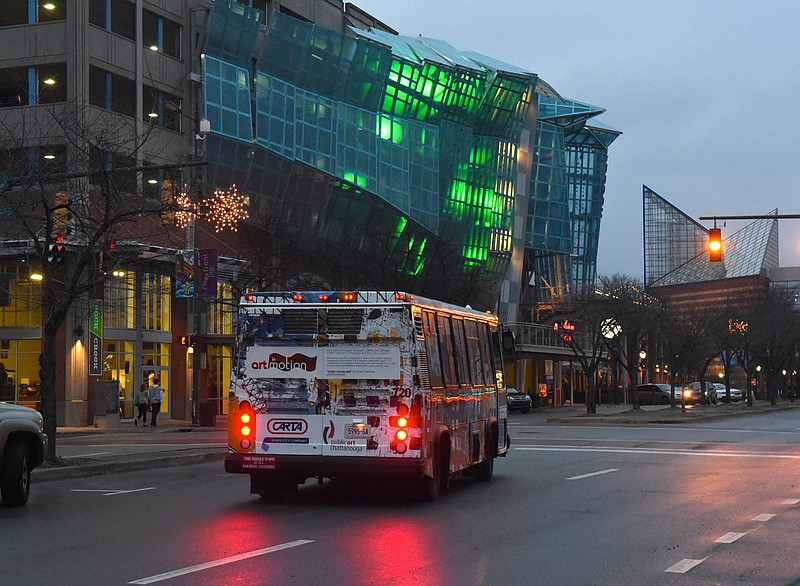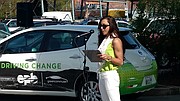Outlook 2018
The new year begins with the strongest economy in Chattanooga in more than a decade. A year-end survey found small businesses owners across America to be as optimistic in their business outlook as any time since the 1980s. Last year, the Chattanooga area added jobs at three times the pace of the country as a whole and the local economy is poised for another year of expansion. As the economic recovery enters its eighth year, sustaining the the same pace of economic growth and momentum is getting tougher, especially in a tight labor market with interest rates expected to edge higher through 2018. Nonetheless, the Chattanooga region is poised for growth this year from more road building, new battery-powered vehicles, additional apartment and subdivision development and continued growth in the region's changing entertainment and dining landscape.
Chattanooga already has a high-voltage history in electric vehicles with CARTA's long-running battery-powered shuttle buses. But new and proposed transportation initiatives in the city and region are charging up that reputation even more.
Volkswagen will likely start making electric vehicles in North America by 2023 and the German automaker's Chattanooga assembly plant could be the location. While no formal action has been taken to make VW electric vehicles in Chattanooga, a SUV concept called the I.D. Crozz that's slated for sale in the United States in 2020 could be the first.
Plugged In
Electric vehicle sales in the U.S. in 2017 were ahead of 2016 through November. Below are 2017 monthly figures and 2016 comparisons in parenthesis:* January - 11,004 (6,221)* February - 12,375 (7,763)* March - 18,542 (13,857)* April - 13,367 (10,531)* May - 16,596 (11,467)* June - 17,053 (14,863)* July - 15,540 (13,067)* August - 16,639 (14,592)* September - 21,332 (17,224)* October - 14,315 (11,007)* November - 17,178 (13,237)* Total - 173,941 (158,614)Source: Inside EVs
The Volkswagen Group's board has approved plans to invest some $41 billion globally over the next five years in electric mobility and autonomous driving capabilities, with the intention of being the world's biggest electric carmaker by 2025.
The group, which also owns the Audi, Porsche, Bentley and Skoda brands, aims to make 1 million electric cars a year by 2025.
Karl Brauer, executive publisher of Autotrader and Kelley Blue Book, says that local production is "always better from a cost perspective" for an automaker.
Brauer says VW has taken a new approach toward electric vehicles and battery power.
"They're being very aggressive," he says. "They've definitely picked their course and now they're executing."
Volkswagen's goal is to build 15 different EVs globally by 2025 using its modular electric platform which will underpin all future VW-branded electric vehicles, according to the automaker.
In addition to the I.D. Crozz, the I.D. Buzz, an all-electric vehicle that recalls the iconic VW Microbus, will arrive in the U.S. in 2022, the car company says.
Brauer says that even though EV sales are still small compared to the entire market, there has been a shift from the electric vehicle as a toy or a third car to a full-fledged replacement as a single-family car.
"Price is the key," he says. VW said it plans to sell the I.D. Crozz for about the same as similar-sized vehicles with an internal combustion engine. "It's the breakthrough EVs never had before and always needed," Brauer says.
When it comes to electric vehicle manufacturing, Nissan late last year began producing its newest all-electric Leaf in nearby Smyrna, Tennessee.
Jose Munoz, the chairman of Nissan North America, says there is "very clear, strong natural demand" for electric vehicles. Munoz tells the Associated Press that Nissan has "built a very strong foundation because we are global leaders on EV."
The Renault-Nissan-Mitsubishi alliance announced last September that it plans to produce 12 new electric models by 2022 and that electric cars will make up 30 percent of its overall output.
"We're going to continue betting on this," Munoz says.
Meanwhile, Chattanooga electricity distributor EPB last year boosted EV ride sharing in the city by sponsoring the roll out of three Tennessee-made Nissan Leafs and cutting the cost of renting the cars. EPB is working with Green Commuter, which had earlier unveiled its membership-based, fully automated program offering access to a network of electric vehicles in Chattanooga.
J.Ed. Marston, EPB's marketing vice president, terms the ride-sharing vehicles "a great option for people to commute around town in ways that support Chattanooga's environmental stewardship."
The Green Commuter Leafs are available at charging stations throughout the Chattanooga area.
Lisa Maragnano, CARTA's executive director, says the aim is to make sure Chattanoogans have choices. All of the 20 or so Nissan Leafs in the program, including the three EPB-branded vehicles, are on a transit route, she says.
Maragnano says users can bike to a bus stop, travel to a ride-sharing location and pick up an electric vehicle. On average, a user could save $9,000 a year.
CARTA last year marked 25 years since the start-up of its electric shuttle route downtown. Over that period, CARTA's shuttle has carried an estimated 15 million passengers.
"People take it for granted," says Rick Hitchcock, a former CARTA chairman. "Every city doesn't have this. Dang, nearly no other city has this."
CARTA says it plans to keep two longtime mainstays of the shuttle system - no rider fares and its battery-powered buses.
While the shuttle expanded to the North Shore in 2007, there is also talk of running it to the Southside, such as down Main Street. But, any expansion would need funding, according to CARTA, which says that shuttle ridership is split pretty evenly between tourists and local residents, depending on the time of year.

